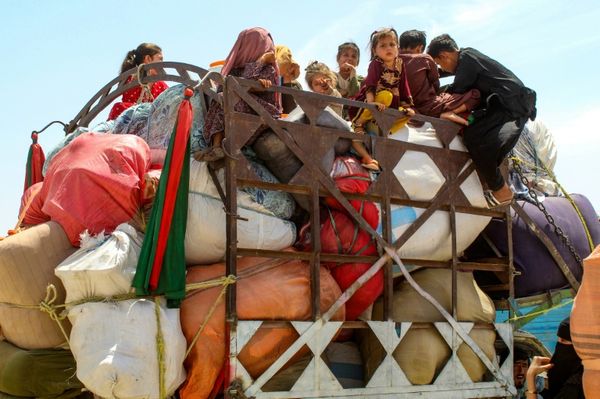
Alexandra Bircken likes to open things up and have a good tinker with their insides. In her current show in London, she cut the V10 engine from an Audi RS 6 into six imposing slices, or rather she got a man in Stuttgart with a massive bandsaw to do it. “These were once crazy, speedy machines,” Bircken says. But cleaned of oil and sliced up like a loaf, the engine has been stilled. Can those chains, wheels and axles really have propelled passengers so far and so fast? And what does it mean when a mechanism no longer works?
It’s a question posed by the show, which Bircken has named Gebrochenes Pferd, German for Broken Horse. The central sculpture is a toy horse painted black, with a tail of silver LED wires. It has been cut into two halves joined by a hinge, so it lies collapsed on the floor. “I often refer to the motorbikes I use in my work as modern horses,” Bircken says – and indeed, in another room, there is a BMW motorbike with its back half removed. “They’re so much to do with speed and dominance and acceleration,” she continues. “So it felt kind of fitting to put a stop to this. Because the times that we are in, all that is crumbling.”
Echoing this, there is wallpaper on which the signature of Christine Lagarde, president of the European Central Bank, has been taken from a €50 note and made to run upwards rather than along the wall, the strange pattern perhaps another sign that there is a spanner in the works of the political and economic system. But the hinge on the horse offers hope: one day, says Bircken, it will stand up again, like “a resurrection”.
The 56-year-old artist was brought up in Remscheid, near Cologne. As a girl, she wanted to be a surgeon. “I had problems with my intestines so I was in hospital a lot,” she says. “I’m interested in when they open up your body. You can’t really see inside, but you want to understand what’s happening. My fascination with machines probably started from how organs work.”
Cars were omnipresent as West Germany’s economy boomed. Bircken’s father was a motor engineer, but then he transferred his talents to the weapons firms Mauser and Heckler & Koch, which outraged his daughter, who in her teens was part of Germany’s peace movement. “He was going to Africa to do deals,” she says. “There were weapons in the house. I was super ashamed.”
At 15, she became great friends with local teenagers Wolfgang Tillmans and Lutz Huelle, who later became an artist and a fashion designer respectively. All three moved to the UK, to get involved in club culture and street fashion after reading about it in British style magazines such as i-D and the Face. In 1991, Bircken went to Central Saint Martins in London to study fashion. “I was really drawn to this whole thing of questioning your identity, which was around much more than it was in Germany.”
Bircken was at CSM when John Major was prime minister, loving being in the thick of a London then affordable to students. “In Soho there was no Starbucks,” she says, “and there were so many empty shops.” She lived in Brixton, relishing “amazing” club nights like Daisy Chain at The Fridge, a gay house music night.
In 1992, Tillmans, who had studied photography in Bournemouth, used Bircken and Huelle in a fashion shoot published in i-D called Like Brother Like Sister. In one image, the androgynous young duo sit in a tree, naked except for their open raincoats. In another, Bircken holds Huelle’s penis. The pictures, which signalled a new attitude to gender and sexuality, put Tillmans on the map: Lutz & Alex Sitting in the Trees is now in the collection of MoMA in New York. Bircken used to get recognised from the series, which got on her nerves. But she never felt “reduced to it. It expressed our relationship at the time.” The trio are still close.
After CSM, Bircken and a colleague started their own fashion label, but she became frustrated by the way clothes were always expected to make their wearer look more beautiful, especially as fashion became more commercial. “When you do fashion, the purpose is to decorate and engage and express what’s outside,” she says. “Whereas with art, it’s more timeless. It can be more introspective and also be a bit less attractive, you know? More honest.”
Freed from the restrictions of the fashion industry, Bircken decided to explore her fascination with skins and membranes, the thresholds between our gooey interiors and the sharp or abrasive world outside. She displayed motorcycle leathers grazed by their wearers touching the road at speed, cut open and flattened out like animal skins. In a 2022 installation in Berlin, she filled a room with gimp suits collapsed around the space. “They were second skins,” she says, “cut to body shape and just left loose, like deflated bodies.”
In 2017, Bircken displayed perhaps the ultimate barrier between human and world: the placenta that followed the birth of her second child. She showed it in a Perspex box filled with preservative, provided by a pathologist in Bonn; it was exhibited at the subsequent Venice Biennale. Bircken called the piece The Origin of the World, appropriating the title of Gustave Courbet’s 1866 painting of the naked vulva of a reclining woman whose head is cropped off, which she says was a feminist statement “purposely taking that title away from a man”.
She regards the placenta as a ready-made artwork created by her body, as well as something that “filtered my bloodstream into the baby and vice versa”, keeping her daughter, now 12, nourished her in the womb. The placenta, she adds, is “the only organ where both DNAs are mixed, mother and child. That’s amazing.” Bircken is choosy about where she displays the work, not least because it arrived back from Venice upside down in its crate. She says she will never sell it. “From the standpoint of medicine, the placenta belongs to the child. If that conception hadn’t happened, this thing wouldn’t have been produced. So if anything, it belongs to her.”
Bircken sees echoes of our interior organs in the world of technology. For CNS, a work in the new show, she stripped out the cable harness from a BMW. She likens this network of wires, operating everything from the lights to the wipers, to the central nervous system. In another sculpture, made from old Land Rover parts, she has plaited multicoloured wires to look like the fabrics she worked with as a fashion designer. Ultimately, she says, these things are all on the same continuum – despite the fact that, until recently, textiles were ghettoised as craft rather than art, marginalising the women working with them.
“Textiles are one of the earliest human achievements,” she says. “It started with braiding hair, then went on to making cloth to cover and protect ourselves.” She sees a correlation, too, between the patterns of a loom and the zeros and ones of the first binary computer language. “And so somehow,” she concludes, “there’s a link between mechanics, text and textiles – and that I find fascinating.”







